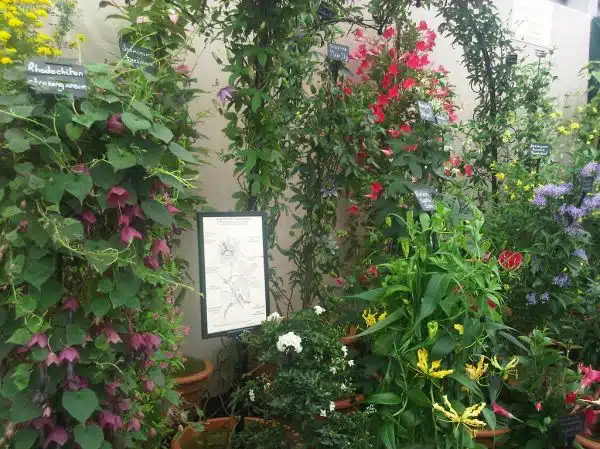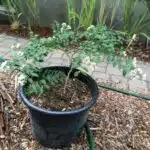Rhodochiton is a genus of flowering plants that belongs to the family Gesneriaceae. These plants are native to Mexico and Central America, and they are known for their beautiful, bell-shaped flowers that come in different shades of pink, purple, and white. Rhodochitons are becoming increasingly popular among gardeners due to their unique appearance and versatility.
Growing and caring for rhodochitons requires attention to detail and some basic knowledge of horticulture. In this article, we will discuss the most important aspects of growing and caring for rhodochitons, including soil requirements, watering needs, fertilization, pruning, and pest control. By following these guidelines, you can ensure that your rhodochitons thrive and provide a stunning display of color in your garden or indoor space.
Understanding The Rhodochiton Genus
Rhodochiton species are a group of unique flowering plants that belong to the family Gesneriaceae. These plants are native to Mexico and Central America and are known for their spectacular trumpet-shaped flowers that come in a range of colors, including pink, purple, and red. The Rhodochiton genus comprises around 15 species, each with its own distinctive features.
One unique feature of Rhodochitons is their climbing habit. They are versatile climbers that can grow up to 10 feet tall and require support from trellises or other structures. Another unique feature is their lush foliage, which is usually deep green and glossy. The leaves are ovate or heart-shaped and have serrated edges that add texture to the plant’s appearance.
It is worth noting that Rhodochitons are not the easiest plants to grow. They require specific care instructions to thrive successfully. However, if you’re willing to put in the effort, they can be rewarding additions to your garden or indoor space. In the next section, we’ll discuss how to choose the right soil for your Rhodochiton plants to ensure optimal growth and health.
Choosing The Right Soil For Rhodochitons
Rhodochitons require well-draining soil to grow and thrive. When it comes to choosing the right soil for your rhodochitons, you must consider two main factors: clay vs. loam and pH levels vs. drainage.
Clay soil is composed of fine particles that hold water and nutrients very well. This type of soil can be problematic for rhodochitons because they prefer a well-draining medium. On the other hand, loamy soil is ideal since it offers good drainage while still retaining moisture and nutrients. You can improve the drainage of clay soils by adding organic matter such as compost or leafmold.
Another crucial factor to consider when selecting soil for your rhodochitons is its pH level. Rhodochitons prefer slightly acidic soil with pH levels ranging from 5.5 to 6.5. If the pH level of your soil is too high or too low, it may affect the growth and development of your plant. Therefore, it’s essential to test your soil’s pH level before planting your rhodochitons.
Soil testing techniques for rhodochitons involve taking a sample of the soil from where you want to plant them and sending it to a laboratory for analysis. The results will give you valuable information about the nutrient content, pH level, and texture of your soil so that you can make informed decisions about how best to prepare it for planting.
In preparing the right type of soil for your rhodochitons, choose loamy over clay soils because they provide excellent drainage while still retaining moisture and nutrients in the roots’ vicinity. Also, ensure that your soil’s pH level ranges between 5.5-6.5 by conducting proper testing techniques before planting them in their designated area. Now that we have selected an appropriate type of soil let us look at watering rhodochitons.
Watering Your Rhodochitons
- Rhodochitons require regular watering, with the amount and frequency of watering dependent on the type of soil and the climate in which the plant is being grown.
- When watering Rhodochitons, the soil should be kept moist but not overly wet, with about 1 inch of water per week.
- When it comes to frequency, Rhodochitons should generally be watered once a week, or whenever the soil has become dry to the touch.
- In areas with high temperatures and low humidity, Rhodochitons may require more frequent watering.
- In areas with higher humidity, Rhodochitons may require less frequent watering.
- In order to determine the soil moisture level, it is important to periodically check the soil with your finger or a soil moisture meter.
Amount Of Water
As a horticulturalist, it is essential to provide adequate watering for your rhodochitons. The frequency of watering will depend on various factors such as the size of the plant, type of soil, and environmental conditions. Generally, rhodochitons prefer moist but well-draining soil. Therefore, it is recommended to water them thoroughly once a week during the growing season and reduce the frequency during winter when growth slows down.
Overwatering can be detrimental to your rhodochitons’ health and cause root rot. Signs of overwatering include yellowing leaves, wilting, or mushy stems. To avoid this, ensure that the soil is not waterlogged and drains well. You can do this by using pots with drainage holes or adding perlite or sand to your potting mix to improve drainage.
In conclusion, providing adequate watering for your rhodochitons is crucial for their overall health and growth. By understanding their watering needs and signs of overwatering, you can prevent root rot and ensure that they thrive in their environment. Remember to water them thoroughly once a week during the growing season and adjust the frequency accordingly based on environmental conditions.
Frequency
As a horticulturalist, watering your Rhodochitons is one of the most important tasks to ensure their growth and health. However, it’s not just about how much water you give them but also how often you water them. The frequency of watering is essential in maintaining optimal soil moisture levels, which is crucial for the plant’s overall well-being.
The benefits of frequency are that it helps to prevent overwatering or underwatering your Rhodochitons. Overwatering can lead to root rot and other fungal diseases, while underwatering can cause wilting and stunted growth. Therefore, understanding the frequency of watering can help you strike a balance between providing enough water to keep your plants healthy without causing any harm.
One common mistake with frequency is assuming that all plants require the same amount of water. However, different plants have different needs based on factors such as their size, type of soil they’re planted in, and environmental conditions. Therefore, it’s crucial to pay attention to your Rhodochitons’ individual needs and adjust the frequency accordingly. By doing so, you’ll be able to provide optimal growing conditions for your plants and ensure they thrive in their environment.
Soil Moisture Level
As a horticulturalist, one of the most crucial aspects of taking care of your Rhodochitons is ensuring they have optimal soil moisture levels. Measuring moisture is an essential task to avoid dryness, which can lead to stunted growth and wilting. The right soil moisture level ensures that your plants get enough water while also allowing for proper drainage.
To measure the soil moisture level, you can use a simple tool such as a moisture meter or test the soil by hand. The ideal range for Rhodochitons is between 50-75% of field capacity, which means that the soil should be moist but not waterlogged. It’s important to monitor the moisture level regularly and adjust watering frequency accordingly based on environmental factors such as temperature, humidity, and rainfall.
Maintaining optimal soil moisture levels for your Rhodochitons will help ensure their well-being and promote healthy growth. When watering your plants, it’s essential to provide enough water without overwatering them as this can lead to root rot and other fungal diseases. By measuring moisture regularly and adjusting watering frequency accordingly, you’ll be able to strike a balance that works best for your plants’ individual needs.
Fertilizing Your Rhodochitons
Fertilizing your rhodochitons is an essential step in ensuring their healthy growth and vibrant blooms. It’s the nourishment that fuels the plant’s growth, just like food for humans. Fertilizers come in two types: organic and synthetic. Your choice may depend on several factors such as budget, personal preference, or the availability of resources.
Organic fertilizers are derived from natural sources like compost, manure, or bone meal. They provide a slow-release of nutrients that enriches the soil and promotes microbial activity. Synthetic fertilizers, on the other hand, are chemically formulated to deliver specific nutrients to plants quickly. While they may seem like a convenient option, overuse of synthetic fertilizers can lead to nutrient imbalances in soil and damage to beneficial microorganisms.
When it comes to fertilizing your rhodochitons, frequency trumps quantity. Applying small amounts of fertilizer frequently ensures steady growth and prevents nutrient build-up in the soil. Here are some tips on how to fertilize your rhodochitons effectively:
- Use a balanced fertilizer with equal amounts of nitrogen, phosphorus, and potassium.
- Fertilize during the growing season (spring through summer) when plants are actively growing.
- Water thoroughly after applying fertilizer to prevent root burn.
- Avoid applying fertilizer when foliage is wet as this can cause leaf burn.
Now that you’ve learned about fertilizing your rhodochitons let’s move onto pruning them.
Pruning Your Rhodochitons
After fertilizing your rhodochitons, it’s important to consider pruning as a part of your plant care routine. Pruning is the process of cutting back certain parts of the plant, such as branches or leaves, to promote healthy growth and shape. Proper pruning techniques can help prevent disease and increase flower production.
Timing considerations are important when it comes to pruning your rhodochitons. The best time to prune is during the dormant season or just after flowering. During the dormant season, you can remove any dead or damaged branches without harming the plant’s growth. If you wait until after flowering, you can shape the plant and promote new growth for next season’s blooms.
When it comes to pruning techniques for rhodochitons, there are a few things to keep in mind. First, always use clean, sharp tools to avoid damaging the plant or spreading disease. Second, start by removing any dead or diseased branches before shaping the plant as desired. Finally, be mindful of how much foliage you remove at once – too much can stress the plant and slow down growth.
In considering proper rhodochiton care, pruning is an essential step in promoting healthy growth and maintaining a desirable shape for your plants. With careful timing considerations and proper technique, you can ensure that your rhodochitons thrive year after year. In our next section, we will discuss propagating rhodochitons so that you can share their beauty with others.
Propagating Rhodochitons
One interesting statistic to note is that rhodochitons are relatively easy to propagate compared to other plant species. In fact, they can be propagated through stem cuttings or by seed. However, propagating through stem cuttings is the most common and effective method.
Rhodochiton propagation techniques involve taking stem cuttings from a healthy and mature plant. It is important to use sharp pruning shears to avoid damaging the plant tissue. Cuttings should be taken in late spring or early summer when the plant is actively growing. The cutting should be about 4-6 inches long with 2-3 leaves attached. Remove any leaves from the bottom half of the cutting and dip it in rooting hormone before planting it in a well-draining soil mix.
Ideal propagation conditions for rhodochitons include warm temperatures between 70-80°F and high humidity levels around 70%. It’s important to keep the soil moist but not waterlogged during the rooting process. After planting, cover the cutting with a plastic bag or dome to maintain high humidity levels and promote root growth. Once roots have formed, gradually acclimate the new plant to lower humidity levels before transplanting it into its permanent location.
Moving on from propagating rhodochitons, it’s important to discuss how to successfully transplant them into their permanent location without causing harm or stress to the plant.
Transplanting Rhodochitons
When choosing the right location for transplanting rhodochitons, it is important to consider factors such as the amount of light and water that the plant needs. Proper soil preparation for transplanting rhodochitons is essential for optimal growth and should include ensuring that the soil is well-draining and fertile. Additionally, the soil should be amended with organic material such as compost or manure to improve the soil’s physical structure and nutrient content. Lastly, it is important to make sure that the soil pH is in the range of 5.5-7.0 for optimal growth of rhodochitons.
Choosing The Right Location
When it comes to transplanting rhodochitons, choosing the right location is essential for their growth and survival. One of the most important factors to consider is whether your rhodochitons prefer sun or shade. Ideally, these plants should be placed in areas that receive partial shade or filtered sunlight, as direct sunlight can cause damage to the leaves and flowers. However, if you live in a cooler climate with milder temperatures, then you may want to consider placing your rhodochitons in full sun.
Another crucial aspect to keep in mind when selecting a location for your rhodochitons is the ideal temperature range for these plants. Rhodochitons thrive in warm, humid conditions, so they should be kept away from areas with extreme heat or cold. Additionally, it’s important to avoid areas with strong winds or drafts, which can dry out the soil and damage the delicate leaves and stems of these plants.
In summary, choosing the right location for your rhodochitons plays a vital role in their growth and overall health. To ensure optimal growth conditions for these plants, select an area that receives partial shade or filtered sunlight and has a warm, humid climate. By taking these factors into consideration when transplanting your rhodochitons, you’ll be setting them up for success and enjoying their beautiful blooms for years to come.
Preparing The Soil
Transplanting rhodochitons requires proper preparation of the soil to ensure that the plants receive the necessary nutrients for their growth and development. Before planting, it is essential to assess the soil’s quality and pH level. Rhodochitons thrive in well-drained soil with a pH range of 6.0 to 7.5. If your soil is acidic, you may need to adjust its pH by adding lime or wood ash. On the other hand, if your soil is alkaline, you can lower its pH by adding sulfur.
In addition to adjusting the pH level, compost enrichment should be considered as part of preparing the soil for transplanting rhodochitons. Compost is an excellent source of organic matter that provides essential nutrients and improves water retention capacity in the soil. It also helps improve soil structure and promotes beneficial microorganisms that aid in plant growth.
To enrich your soil with compost, mix it thoroughly with your existing topsoil before transplanting your rhodochitons. You can use homemade compost or purchase commercially available ones from garden centers or nurseries. By using compost enrichment and adjusting the pH level of your soil, you can create a suitable environment for your rhodochitons to flourish and produce beautiful blooms year after year.
Dealing With Common Rhodochiton Pests
Rhodochitons are generally pest-resistant, but infestations can still occur. It is important to take preventative measures to avoid pests from taking hold and causing damage. One effective method is to keep the plant healthy by providing proper nutrition, soil drainage, and adequate lighting. This will reduce the likelihood of infestations and also increase the plant’s ability to fight off any pests that do appear.
If pests do make an appearance, there are natural pest control methods that can be employed before resorting to chemical pesticides. One such method is introducing beneficial insects like ladybugs or lacewings into your garden. These insects feed on common rhodochiton pests like aphids and spider mites. Additionally, spraying a solution of water and dish soap on affected leaves can help control infestations.
Regularly inspecting your rhodochitons for signs of pests is crucial in preventing infestations from getting out of hand. Look for any distorted or discolored leaves, webbing, or small insects crawling on the plant’s surface. Early detection allows for quicker treatment with natural pest control methods before having to resort to stronger chemicals.
Now that we have covered how to prevent and treat common rhodochiton pests, let us move on to overwintering your plants. With proper care during the colder months, you can ensure that your rhodochitons will thrive come springtime.
Overwintering Your Rhodochitons
Rhodochitons are a beautiful and unique addition to any garden or indoor space. However, if you live in an area with harsh winters, it is important to take proper precautions to protect your plant from frost damage. Overwintering techniques for rhodochitons vary depending on the location and climate of your area.
One popular method is to bring your Rhodochiton indoors during the winter months. This will provide a controlled environment that can help protect the plant from harsh temperatures and frost. When bringing your plant indoors, make sure it has adequate sunlight and keep it away from drafts or heaters that could dry out the leaves.
If bringing your Rhodochiton indoors is not an option, you can also use protective measures such as wrapping the plant in burlap or a frost blanket. This will help insulate the plant and prevent frost damage. It is important to regularly check on your plant to ensure it is not being overwatered or undernourished during this time.
- Invest in high-quality frost blankets to ensure maximum protection.
- Consider using a space heater near the plant for added warmth.
- Place a humidifier near the plant to combat dry air caused by indoor heating.
- Monitor soil moisture levels closely during overwintering periods.
By following these overwintering techniques and protecting your Rhodochiton from frost, you can ensure its longevity and health for years to come. In the next section, we will discuss how to enjoy the beauty of your Rhodochitons throughout their growing season.
Enjoying The Beauty Of Your Rhodochitons
Bask in the Beauty of Your Rhodochitons
As a horticulturalist, I am constantly amazed by the beauty and elegance of rhodochitons. These plants are not only easy to care for, but they also add a touch of charm to any garden or indoor space. With their unique trumpet-shaped flowers and heart-shaped leaves, rhodochitons are sure to captivate your attention and give you a sense of tranquility.
One way to showcase the beauty of your rhodochitons is through photography. You can take close-up shots of the flowers or capture them in their natural surroundings. The vibrant colors and intricate details of these plants make for stunning photographs that you can share with others or keep as mementos. Rhodochiton photography is an excellent way to appreciate the splendor of these plants even more.
Another way to enjoy your rhodochitons is by displaying them creatively. You can use them as centerpieces for special occasions or arrange them in decorative pots around your home. Rhodochiton display ideas are endless, from hanging baskets on your porch to placing them on your office desk. The options are only limited by your imagination.
In summary, growing and caring for rhodochitons is a delightful experience that fills any space with elegance and serenity. Take advantage of their natural beauty by capturing it through photography or showcasing it creatively with display ideas. Allow yourself to bask in the charm and allure that these plants have to offer, and share their magnificence with those around you.
Conclusion
The Rhodochiton genus is a beautiful addition to any garden or indoor space. These unique plants require specific care to thrive, but with the right conditions, they can produce stunning flowers and foliage that will bring joy to any gardener.
To properly care for your rhodochitons, it is important to choose the right soil, water them appropriately, fertilize them regularly, prune them when necessary, and transplant them as needed. In addition, be prepared to deal with common pests and provide adequate protection during the winter months.
One way to think of caring for rhodochitons is like tending to a delicate piece of art. Just as an artist must carefully choose their materials and take care in every brush stroke to create a masterpiece, a gardener must choose the right soil and nutrients and tend to their plant’s every need in order for it to flourish into a work of natural beauty. With patience and dedication, you too can enjoy the stunning beauty of these unique plants.
Image Credits
- “Rhodochiton atrosanguineus (Black Man’s Willy), Passiflora Clear Sky, Gloriosa superba citrina (Yellow Flame Lily)” by Alwyn Ladell (featured)





























